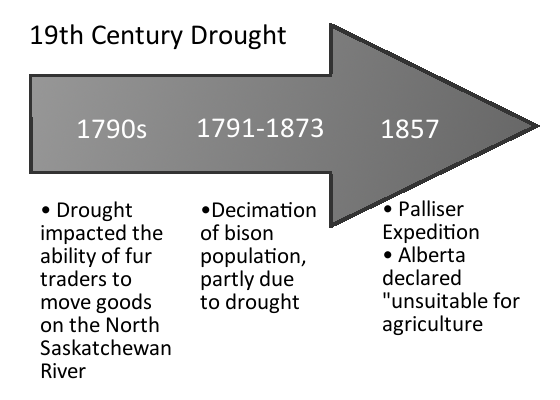Drought in 19th Century Alberta
 |
| Figure 1: Drought in 19th Century Alberta |
Early Accounts of Drought in the 1700s
Drought occurred in present-day Alberta throughout the 1700s. Drought became so extreme in the 1790s that the North Saskatchewan River ran so low – and even dry at one point – and fur traders were unable to move their goods down the river as a result [1]. Drought in 1850 had the same impact [2].
Decimation of the Bison Population
 |
| “Bison With Texture” by Pam Morris is is licenced under CC BY 2.0. |
In the late 1790s, a decimation of the bison population began. Bison were a primary source of food and materials for Alberta’s first human residents [3].
However, as more Europeans began arriving in the region (Europeans had been coming to the West since the 17th century), they started to hunt the bison population for food and also with the purpose of negatively affecting the Aboriginal population [4].
During the eight decades (1791 – 1873) that Europeans were hunting the bison, there was also a multi-decadal drought. The drought impacted water supply for humans, and also reduced the water supply and available forage for the bison. The drought and the ongoing hunting efforts decimated the bison herds “nearly to extinction” [5].
The Palliser Expedition
Captain John Palliser – an explorer and geographer – was funded by the British government to embark on a scientific exploration in present-day western Canada. His purpose was to survey the land (and whether there was any potential for agriculture) and explore possible routes for the Canadian Pacific Railway. Palliser’s adventure became known as the “Palliser Expedition”, and lasted from 1857 – 1860.
When Palliser arrived in western Canada the region was in the midst of a multi-decade drought. Palliser explored what is now known as the “Palliser Triangle” – a triangular area of about 200,000 square kilometres that spans present-day southern Saskatchewan and southeastern Alberta. The Palliser Triangle is now considered to be both the breadbasket of the country, but also the driest part of the Canadian Prairie provinces. Palliser famously declared the region as being unsuitable for settlement – it was simply too dry.
Settlement of Alberta
The federal government ignored Palliser’s warning that the Prairie Provinces were too dry for successful settlement, and began to encourage immigration to the region and advertising the area as “fertile ground to establish farm operations [6].
The Canadian Pacific Railway reached present-day Alberta in 1883, opening up the area to more newcomers. By the late 1890s, immigration to the west was well underway, despite a decade-long drought that occurred from 1885-1896.
The Canadian government eventually recognized that drought would be problematic for future settlement in the West. This concern was addressed in following years by the assessment of possibilities for irrigation in the region.
Sources:
[1] CBC News. (2009, July 10). Parched prairies: latest drought a sign of things to come. CBC News. Retrieved from http://www.cbc.ca/news/canada/parched-prairies-latest-drought-a-sign-of-things-to-come-1.845429
[2] Environment Alberta. (2008, January). Focus on Climate Change. Government of Alberta. Retrieved from http://environment.gov.ab.ca/info/library/7390.pdf
[3] Mitchell, J. A. & Gates, C. C. (2002, January). Status of the Wood Bison in Alberta. Alberta Sustainable Resource Development. Retrieved from http://www.ab-conservation.com/go/default/assets/File/Programs /AWSR/Mammal%20Reports/Status%20of%20Wood%20Bison%20in%20Alberta_2002.pdf
[4] A. Bailey et al. (2010, October). Politics, Policy, Settlers, and Consequences for Canadian Prairie Grasslands: A Range Management Perspective. Rangelands: Society for Range Management. Retrieved online http://www1.foragebeef.ca/$Foragebeef/frgebeef.nsf/all/frg26/$FILE/range101politicspolicy.pdf
[6] Parks Canada. (2009). The Palliser Expedition. National Historic Sites in the Mountain National Parks. Retrieved online http://www.pc.gc.ca/docs/v-g/pm-mp/lhn-nhs/ehn-ens/palliser_e.asp
